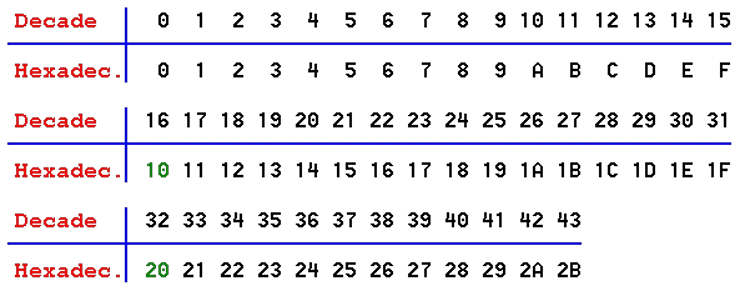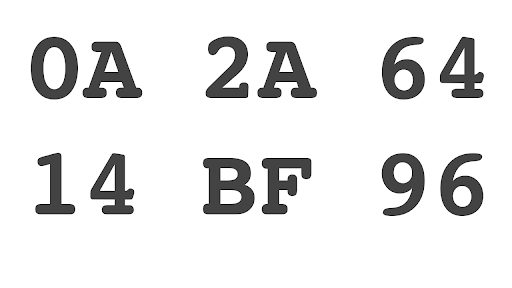How to Represent Negative Hexadecimal Numbers
The simplest method to represent negative binary numbers is called Signed Magnitude. -- Jun 6 06 2 Vladimir Oka.

Number Systems Introduction Decimal Binary Octal Hexadecimal Youtube
568 oct 0001070 83 7 8 -568 oct 7776710 verify the sum is zero.

. Hexadecimal can also be used to express the exact bit patterns used in the processor so a sequence of hexadecimal digits may represent a signed or even a floating-point value. The decimal value of any hexadecimal number can be determined using sum of product of each digit with its positional value. Handling negative integers becomes a bit tricky since we cant write -3AC to represent negative hexadecimal numbers so lets a dive deeper and represent numbers in their binary forms.
The convention is that if the leftmost digit also called the most significant digit or most significant bit is 0 the number is positive. Ii Firstly represent the negative number on the number line. And since any number is bolied down to binary 0s and 1s we face the same issue of representing negative numbers in binary format since a computer wont.
You use the leftmost digit as a sign indication and treat the remaining bits as if they represented an unsigned integer. We also describe how to represent negative integers and floating-point numbers. The meaning of a given sequence of bits within a computer depends on the context.
Facts of Hexadecimal Number System. Given a number N in decimal format the task is to convert it to the hexadecimal representation of N as a string. How to convert negative integer to hexadecimal or octal number.
We can also add two hexadecimal numbers by following this table. 9 2 6 1 A 2 A C 8. Example-1 The number 512 is interpreted as.
Another is twos complement. The advantage of twos complement is that it is. -568 What is the equivalent hexadecimal and octal number.
Iii Then move to the number of units that is equal to the second number from the first negative number to the left. Negative numbers are stored in 2s complement form. They are using twos complement notation to represent negative numbers.
This way the negative number 42 10 can be written as FFFF FFD6 in a 32-bit CPU register in twos-complement as C228 0000 in a 32-bit FPU register or C045 0000 0000 0000 in a 64-bit FPU. In a similar way you could say. Last Updated On September 11 2018.
If you want to negate 15 youd get -15. The binary value needs to be logically inverted and then 1 needs to be added to that. In the real world the hexadecimal F base 16 015 is equal to the decimal value 15 base 10 what we are used to 09.
You just have to put the values of the binary number to the relevant hexadecimal number. 134 00000000000000000000000010001000 in 32 bit representation. One is to use a sign bit where the MSB represents the sign 1 meaning negative.
If you got the carry then represent it on the top of the first number next digit and result on the bottom of the second number added digit. Here you invert all the bits and then add 1 to the result. The result converted to hex represents the hex value of the respective negative decimal number.
5122x16 2 0x16 1 0x16 0 200. Therefore 11100011 2 E3 16. The hexadecimal value of a negative decimal number can be obtained starting from the binary value of that decimal number positive value.
Binary to hexadecimal conversion is a simple method to do. The binary value needs to be negated and then to add 1. Here right most bit 0 is the least significant bit LSB and left most bit 2 is the most significant bit MSB.
The result converted to hex represents the hex value of the respective negative decimal number. A simple example on how to represent a negative decimal number in binary and Hex using 2s complement. Continue the process until you left nothing on the left side.
568 hex 0000238 2 162 3 16 8 -568 hex FFFFDC8 verify the sum is zero. Thus 01 still represents 1 and FF represents -1. In this section we describe how to represent integers in binary decimal and hexadecimal and how to convert between different representations.
The hexadecimal value of a negative decimal number can be obtained starting from the binary value of that decimal numbers absolute value. Addition of Negative Numbers on a Number Line i Take two negative numbers. To get it you start with your value express it in binary change all the 0s to 1s and vice versa then add 1.
You can do it directly in hex subtracting each digit from 15 then adding 1. Iv At last note down the final number to know the addition of two negative numbers. So 926 1A2 AC8.
From the table we can write 11100011 as E3. Thus 01 would represent 1 and 81 would represent -1 for two digit Hex numbers. Convert 11100011 2 to hexadecimal.

Hex Numbers Addition Calculator

Pin By Debasish Mohapatra On Projects To Try Positive Numbers Notations Decimal Number
The Negative Numbers Representation In Hex Technosoft Motion Control

Hexadecimal Number System Video Khan Academy

Negative Decimal Number In Binary And Hex Youtube

Conversion Of Binary Or Hexadecimal To Ascii And Decimal In Embedded C Blogging Tech Tipps Decimal Conversion Computer Coding Decimals

Convert Number To Hexadecimal Solving A Short Facebook Interview Question Dev Community

Adding Hexadecimal Numbers Youtube

Hexadecimal Multiplication Best Brain Teasers Converting Decimals

How To Convert Decimal To Hexadecimal Youtube

Hexadecimal How Does Ff 255 Beginners Questions Renoise Renoise Forums

Hexadecimal To Decimal Converter Decimals Life Hacks For School Converting Decimals

Decimal Binary Octal Hex Ascii Conversion Chart Coolguides Decimals Decimal Chart Ascii

The Decimal Binary Octal Hexadecimal Number Systems Number System Binary Number Decimals

Hexadecimal Number System Video Khan Academy



Comments
Post a Comment